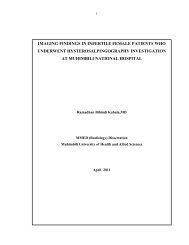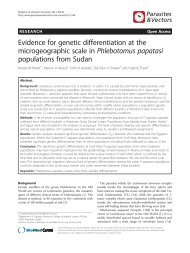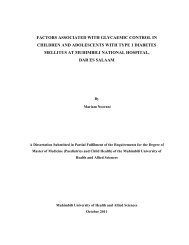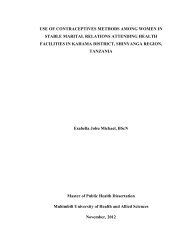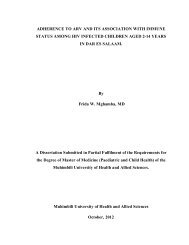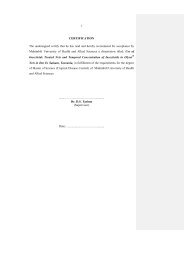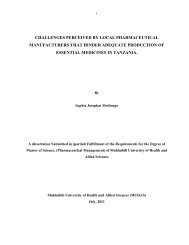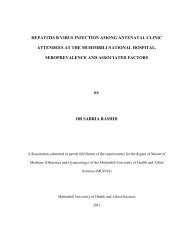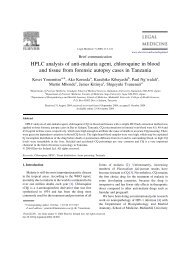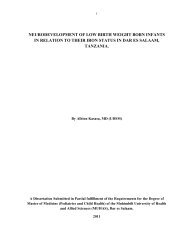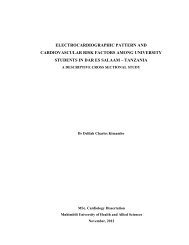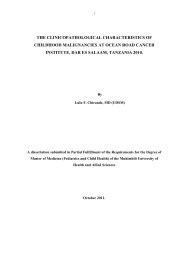MUNISI DISSERTATION REPORT FINAL[1].pdf - muhas
MUNISI DISSERTATION REPORT FINAL[1].pdf - muhas
MUNISI DISSERTATION REPORT FINAL[1].pdf - muhas
Create successful ePaper yourself
Turn your PDF publications into a flip-book with our unique Google optimized e-Paper software.
12<br />
2.1.3. Relationship between STH infections and anthropometric indices of school<br />
children<br />
Soil-transmitted helminths infections rarely cause death. Instead, the burden of disease is<br />
related less to mortality than to the chronic and insidious effects on the hosts’ health and<br />
nutritional status (Stephenson et al., 2000). Chronic STH infections resulting from Ascaris<br />
lumbricoides, Trichuris trichiura, and hookworm can dramatically affect physical and mental<br />
development in children (WHO, 2002). There is now a substantial body of research that<br />
clearly demonstrates how STH infections impair healthy nutrition (Stephenson et al., 2000).<br />
STH impair the nutritional status of the individuals they are infecting in multiple ways, by:<br />
<br />
<br />
<br />
<br />
Feeding on host tissues, including blood, which leads to a loss of iron and protein;<br />
Malabsorption of nutrients;<br />
Competing for vitamin A in the intestine in particular roundworm;<br />
Causing inflammatory responses that may affect appetite and food intake, or<br />
substances that modify the metabolism and storage of key nutrients such as iron<br />
(WHO, 2012).<br />
The three most frequently used indicators of nutritional status of children i.e. height-for-age,<br />
weight-for-age and weight-for-height are based on weight and height measurement (FAO,<br />
2012). Based on these, a child is considered stunted if the child is too short for his/her age.<br />
Stunting reflects failure to receive adequate nutrition over a long period of time and is affected<br />
by recurrent and chronic illness. Height-for-age, therefore, represents the long-term effects of<br />
malnutrition in a population and is not sensitive to recent, short term changes in dietary intake<br />
(National Bureau of Statistics, 2010). The weight-for-height data assesses whether or not the<br />
child is wasted. A child is considered wasted if the child is too thin, that is, weighs too little<br />
for his/her height. Wasting is an indicator of acute or recent nutritional deficits and is closely<br />
tied to mortality risk. The weight-for height indicator also can be used to assess the extent to<br />
which children are overweight or obese, which is an increasing problem among children<br />
worldwide. Finally, the weight-for-age indicator provides an assessment of whether a child<br />
weighs too little for his/her age. A child can be underweight for his/her age because the child


![MUNISI DISSERTATION REPORT FINAL[1].pdf - muhas](https://img.yumpu.com/30272764/24/500x640/munisi-dissertation-report-final1pdf-muhas.jpg)
